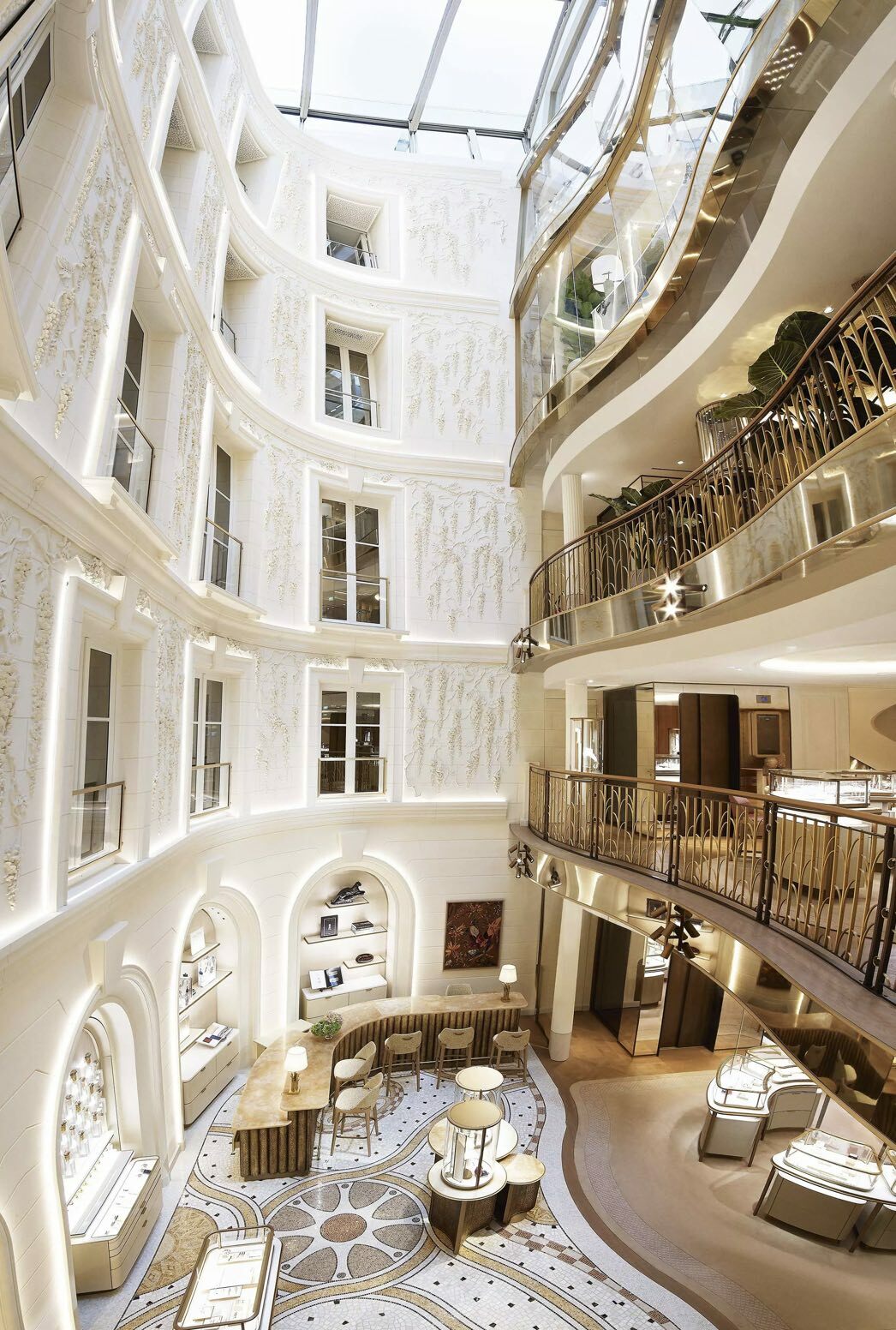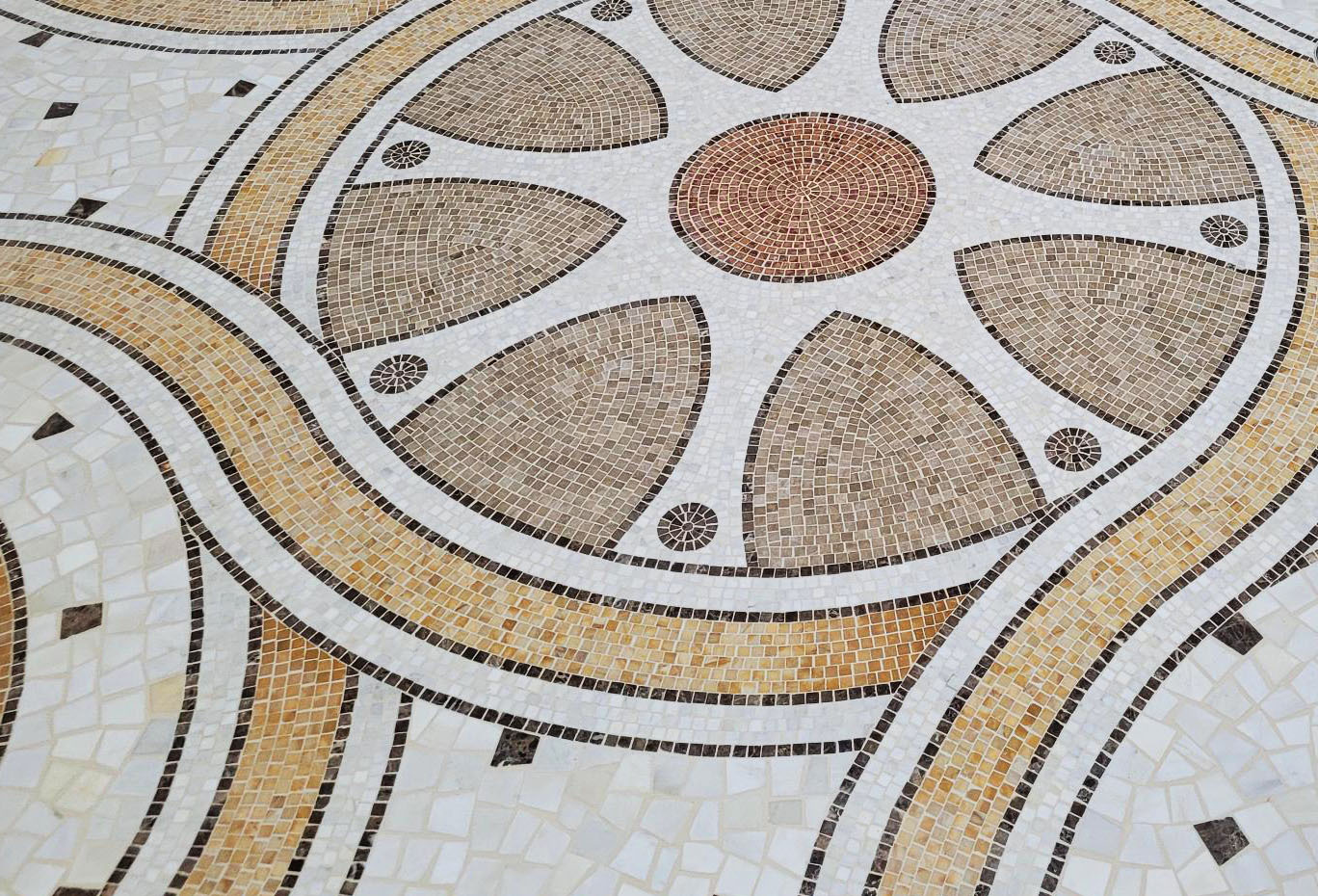Mosaic in the crown
Cartier’s flagship boutique at 13 rue de la Paix , Paris
The consumer trend to think and buy local appears to have caught on among the world’s leading luxe brands, whose take on this new environmentally conscientious phenomenon has led to the interior designers creating boutique spaces that reflect their locations’ architectural heritage and feature locally sourced materials…
Some of the first companies to abandon the ‘universal’ global boutique look include the most avant-garde names in fashion, jewellery and cars – including Cartier, whose new reimagined interior of its flagship store in Paris made an eloquent statement about the Maison’s commitment to this new approach.
In recent times other brands, including Bottega Veneta, began releasing items designed specifically for a specific city, such as Dubai, as a way of honouring clients with an exclusive collection.
Cartier’s flagship boutique at 13 rue de la Paix in Paris is considered to be the jewel in the Maison’s crown, and some of the world’s most glittering designers and suppliers of noble and precious materials were hand-picked to rejuvenate the historic store. The splendid make-over prepared the grand dame of boutiques for today’s generation, with quintessential Parisian interior architectural accents.
The architects and interior designers were given a clear brief: to create an environment that is contemporary but embodies the very essence of Parisienne luxury and exuberance, while respecting the architectural style of the city.

The six floors of interior space are all instantly recognisable as being in Paris, rather than an anonymous and predictable interior without reference to its geographic location. The importance of this approach is underlined by the fact that the property was the first Cartier boutique, which opened when Louis Cartier was himself building his jewellery empire.
“Fortunately, more and more, stores are designed to fit in the city landscape, respecting the style and atmosphere of streets and existing buildings. Luxury Maisons are now key contributors to city urbanism, in a positive way. They become part of the ‘archi-tour’ when one visits a capital city,” wrote Cyrille Vigneron, Cartier President and CEO, in a recent LinkedIn article.
Referring to how luxury brands contribute to city urbanism, he says, “With the two Cartier flagship stores in New York and Paris, the architects have not only respected this localised brief, but have also explored the notion of timelessness, which characterises Cartier jewellery. Timelessness [is] not what ages well, but what does not age, because it cannot be dated.”
Vigneron adds: “How can this translate in architecture? In respecting all periods of time, without being framed in one style only or one era. Like the cathedral of Syracuse in Sicily, where one can see the Greek Doric temple, the Byzantine church, the gothic chapels and the Baroque facade, all in harmony. These two stores are definitely ‘Parisian’ and a ‘New Yorker’ – but not 19th-, 20th- or 21st-century.
“With these principles, these flagships do not only contribute to the city style. They also reconcile the past and present, without nostalgia; without tension between a past to protect or a present to build after scrapping what existed before. They offer a mental alternative: renovate and revitalise. Inside, many local artisans and craftsmen have been called to decorate them, with their savoir faire, and giving a stage to their amazing beauty. Living tradition.”
Three leading architectural firms – Moinard-Bétaille, Studioparisien and Laura Gonzalez – were assigned the task to work together and to harmoniously transform the building's six floors.
Through the creation of a seamless interior narration that invites visitors on a dazzling design journey from the ground floor upwards, one can discover a new boutique flooded with light, brightness and positivity, ultimately leading to the archives, design studio, a winter garden and the Residence on the upper floors.
The historic building’s neo-Classical iconic black and gold Portoro marble façade was left untouched, while the architects made substantial changes to the 3,000-metre square interior in Cartier’s universal style and identity. Using the elements of history and time, the designers were tasked with creating something new, different and inviting.
The artisanal services of some 40 global workshops, headed by a dozen master craftsmen, were meticulously selected to create lacquer, woodwork, stonework, stuccowork, metal work and mosaics for the bright new interiors found throughout the multi-level boutique.

Fantini Mosaici was among the few companies who excel in their fields and chosen to participate in this major renovation of this boutique, which lies at the heart of one of the world’s best respected luxury brands. Some of the others also regarded as the best in their métier and commissioned to add their finesse to the interior décor included: Atelier Pierre Bonnefille, surface patina; Jean-Daniel Gary, inlaid textured glass; and marquetry connoisseur Lison de Caunes, decorative gold sundial inspired decorative appliques.
Headed by their master artisan, the Fantini Mosaici team placed thousands of mosaic tesserae in various parts of the luxury store – including the Bridal, Feminine and Perfume Universes – as well as mosaic accents for various arch ways.
For many months during the renovation, which lasted for over two years, with the precision of a diamond cutter the specialist mosaicists hand-cut and laid the marble mosaic tesserae, to complement the jewel-like surroundings. Artistic marble mosaics in several colours – including Giallo Siena, Giallo Reale, Giallo Jerusaleme, Rosso Verona, Rosso Francia, Rosso Alicante, Rosa Portogallo, Verde Alpi, Diaspro, Botticino and Bianco Lasa – were used to complement the new dream-like environment.

Earlier this year, the Maison opened its renovated Five Avenue mansion in New York City, and its new boutique in Abu Dhabi’s chic Galleria Mall has recently been refurbished. Again, it was the Fantini Mosaici craftsmanship that they relied upon to highlight key areas.
As Cartier continues its quest to beautify its global boutiques in keeping with the vision of each boutique reflecting the design and heritage of its location, the artisans in the Fantini Mosaici atelier are also creating luxury mosaics to be soon installed in their New Delhi boutique. They are also working in tandem with the architects for mosaic installation in the upcoming new boutiques – or ‘Temples’ as Cartier refers to them – in Monte Carlo, Riyadh and Kuwait.
“Cartier is not anchored in one city or one period of time. We find inspiration in many sources, like the Islamic world, India’s maharajahs, European Art Deco and much more, all of which now blend into the architecture of our house,” Vigneron said in an interview with the New York Times.
For decades the world’s top jewellery brands, including De Beers, Patek Philippe and Pomellato, have entrusted Fantini Mosaici with the creation and installation of mosaic and stone works for their finest boutiques.


